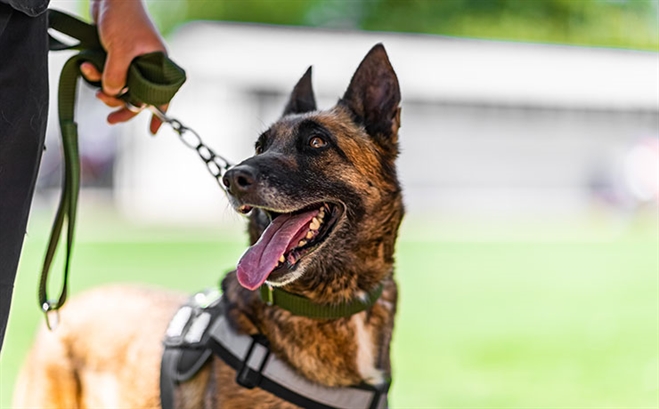Sean’s K-9s Fund Dogs, For a Cause
September 29, 2022 by Peter Friesen

In a large, crowded arena, while people pour through the gates, there’s likely a K-9 dog walking around on the job. Although such dogs are a common sight, it can cost departments well over $100,000 to buy, train, and care for them.
The nonprofit Sean’s K-9s helps law enforcement agencies with a part of that burden, covering the cost of dogs across the country, as well as supplying grants for training and equipment.
K-9s For a Cause
Cheryl Walsh started Sean’s K-9s in honor of her son Sean, who was killed in action in Afghanistan just 10 days before he was set to return home to Santa Clara, California, to become a K-9 officer.
The first Sean’s K-9s grant was funded in 2011, to provide the Santa Clara Police Department with a dog. As of 2022, Walsh has provided grants to around 35 agencies from California to New York. When an agency has a need — for a dog, equipment, or training — they reach out to Walsh, who puts together donations of up to $10,000.
How To Pick the Right Dog For the Job
K-9 dogs fall into two categories: single purpose and dual purpose. Single purpose dogs are trained to sniff out explosives, electronics, or narcotics, as well as track people. Dual-purpose dogs are trained on scent detection but also trained to accompany an officer on day-to-day patrol.
The ideal breeds vary widely based on the type of work, Walsh says, with the archetypal German Shepherd being trained for dual-purpose work, along with Dutch and Belgian Shepherds.
Single-purpose dogs can be Labrador retrievers, Cocker Spaniels, or Basset Hounds, depending on a department’s needs.
Often, a law enforcement agency will connect with a kennel that provides dogs and training and select a dog based on need, as well as connection with the handler. Depending on the state requirements, patrol training is around six weeks, followed by several weeks of scent detection training.
The Steep Startup Costs of K-9 Units
The startup costs to obtain, train, and care for a K-9 dog are high — up to $120,000, Walsh says. Her goal is just to provide the dog, which is often the sticking point. Once there’s a dog in hand, the rest of the money usually falls into place.
Once adopted, dogs live at their handler’s home in spacious outdoor kennels that are well-protected from the elements. On patrol, they sit in the back of a specially outfitted patrol car or SUV, with water and a heat alarm. The ongoing costs include vet bills and sometimes special food.
“It's more expensive to start a K-9 unit than it is to maintain one,” Walsh says. “A lot of times when a new chief comes in, they may be thinking about when the dog's ready to retire, just doing away with the K-9 program because they may not have it in the budget to spend $10,000 or $12,000 on a dog."
That’s where Sean’s K-9s can step in to cover the cost of the dog, so the department won’t have to start from nothing in a few years if they want another unit.
Walsh has also provided equipment grants, including supplying a heat alarm and backup fan for a department in Arkansas with just 10 officers and one K-9 dog. A partnership with Tyler Technologies provided a K-9 to the Cheyenne, Wyoming, police department and ensured the dog’s training, food, and veterinary costs would be covered.
Stop and Say Hi to a K-9
For Walsh, the nonprofit has been her way to continue honoring her son’s goal of working as a K-9 officer, through providing animals and educating the public on K-9s. The dogs are often friendlier than people expect, Walsh says, though if you see one — say at a busy arena — it’s important to recognize the dog is on duty.
“When you see a dog with a handler, always ask, ‘Is it okay to approach?’” Walsh explains. “The dog might be working a big event, a crowd. When there’s a big crowd, the dog is on very high alert.
“These dogs, if they’re working, respect it.”